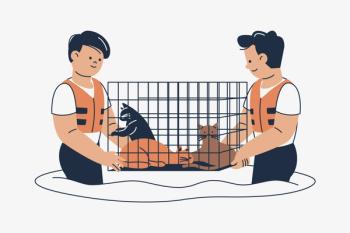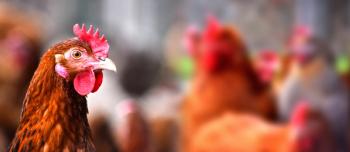
Why small animal veterinarians should care about farm animals
Concern for animals slaughtered in the U.S. should be part of the veterinarian's oath.
Growing up in suburban Long Island, New York, I had no knowledge or understanding of how animals on farms were cared for or where my food came from. I first became aware of how food animals were treated in the book Animal Liberation by Peter Singer,1 which I read long after graduation from veterinary school.
In the United States, we raise and kill approximately 9 billion animals per year on farms far removed from the clean offices where we practice as small animal veterinarians. Singer and others2 have described how over the past 60 years animal agriculture has shifted from a culture of husbandry, in which the farmer was a steward of his or her small herd living on pasture and felt a responsibility to ensure the animals' welfare, to its present state of industrialization, in which animals are bred to be increasingly large, processed in higher numbers and confined in smaller spaces. We have moved from an era in which farmers were the animal's caretaker to one in which we have sacrificed virtually any commitment to farm animal well-being.
According to the American Veterinary Medical Association (AVMA), approximately 77 percent of veterinarians in 2012 practiced exclusively or part-time on small animals.3 Many of these small animal veterinarians have adopted dogs or cats that others relinquished and are helping to improve the lives of their future patients by volunteering at spay-neuter clinics and contributing time and discounts to local rescues and other humane organizations. Yet our actions don't seem to extend to animals we don't see or interact with—animals that desperately need our assistance.
The case for farm animals
According to the AVMA, there are approximately 70 million pet dogs and 74 million pet cats in the United States.4 Comparatively, the number of animals slaughtered in the United States in 2011 was more than 9 billion, as follows:
> 8.7 billion chickens
> 246 million turkeys
> 110 million pigs.5
For those less inclined to follow decimal points, consider this: The number of turkeys slaughtered in one year far surpasses the number of pet dogs and cats combined, and the number of farm animals killed in one year is more than 60 times the number of pet dogs and cats combined. If for no other reason than the sheer magnitude of these numbers, the plight of farm animals warrants our concern. Here are a few considerations:
Housing and confinement of pigs. More than three-quarters of breeding pigs (approximately 6 million) are confined in gestation crates—metal cages approximately 2 feet wide by 7 feet long. Sows are unable to turn around in this cramped space and live in these crates for four months without respite. A few weeks after nursing is completed, she is impregnated and transferred back to the gestation crate. A breeding pig thus spends nearly every moment of her life confined to a degree of virtual immobilization.6
Housing and confinement of chickens. In the United States, approximately 95 percent of egg-producing chickens (estimated at 280 million) are confined inside battery cages.7 Standing practice confines eight hens in a cage so that each bird has less space than a letter-sized piece of paper on which to stand.8 Thus confined, hens are unable to manifest normal behaviors such as nesting and perching.
Slaughter of chickens. The birds are removed from transport crates and placed upside-down by their legs in shackles onto a conveyor belt. Most chickens are stunned in an electrified water bath, which immobilizes them prior to slaughter via an automated knife, which results in death via exsanguination. Given the rapid speeds of these conveyors (150 birds per minute), some birds miss the knife and are likely still alive before entering a scald tank.8
Hens contained in battery cages on an egg factory farm in Texas, where countless dead birds were discovered in cages with live birds. (Photos courtesy of the Humane Society of the United States.)
Slaughter of pigs. Pigs are rendered insensible prior to slaughter using either a captive bolt gun, electric current or CO2 gassing. Each of these stunning methods depends on proper equipment and training of personnel. The animal is then shackled and hoisted by a hind limb and exsanguinated via a cut to the pectoral region.9
Sows in gestation crates at a Wyoming pig breeding facility owned by a pork supplier for Tyson Foods and Jimmy Dean.
Cognitive abilities of chickens. Observation of chickens in their natural environment reveal them to be capable of social attachments and preferences and to have cognitive skills rivaling those of mammals.10
Cognitive abilities of pigs. Pigs are highly intelligent, curious animals. According to a recent study in the journal Animal Cognition, "Animal welfare scientists ... share the opinion that pigs have considerable cognitive abilities. The public's perception of the intelligence of an animal influences the importance attached to its welfare, and many consumers consider farming practices that result in poor animal welfare to be unacceptable."11
The state of legal protection
Although most states have laws protecting dogs and cats from neglect, malicious cruelty and abandonment, animals raised for food are essentially exempt from similar protections because of presumed reasonable economic interests and cultural norms.12
In 1958 Congress passed the Humane Slaughter Act to ensure that animals used for food were slaughtered humanely. Yet chickens and turkeys, which constitute more than 90 percent of animals killed for food, are exempted from protection under this act. The Animal Welfare Act, enacted in 1966, excludes all animals used in agriculture from government protection. As it stands now, those with an economic interest in raising animals for food dictate standards of acceptable care. The recent proliferation of legislation in agricultural states to ban the photographing and videotaping of animals on farms reveals how determined the agriculture industry is to conceal present methods of animal handling from the public.13
Public response
In May 2003, a Gallup poll demonstrated that 75 percent of Americans want to see federal legislation enacted that would ensure the well-being of farm animals.2 It's clear that when the public is informed about the methods by which animals are raised and slaughtered, their response is one of compassion. Nine states have passed laws via ballot initiative in the past decade mandating the eradication of certain extreme confinement methods (see the list on p. 42).
States that have banned extreme confinement methods
Veterinary response
Organized veterinary groups have had little meaningful impact on the welfare of farm animals, likely as a consequence of the interdependent relationship between a subset of large animal veterinarians and the agriculture industry. In fact, when a citizen initiative (Proposition 2) was on the California ballot in 2008 to provide that farm animals be able to move and extend their limbs, the AVMA did not endorse the measure, asserting that there was not enough science to ensure animal safety with increased living space.14 Sixty-three percent of the general population of California passed the measure.
Small animal veterinarians are obliged by virtue of our oath to "prevent and relieve animal suffering," which means broadening our scope of moral concern beyond the pets we care for each day to include animals we are less emotionally attached to and do not see or hear behind slaughterhouse doors. The sheer number of animals affected makes this, in my consideration, the most important animal welfare issue. As we cannot rely on legal protections nor the agriculture industry to improve the welfare of farm animals, we must take individual actions to help. These can include:
> Lobbying for legislation mandating improved treatment of farm animals
> Encouraging food retailers to improve animal care from their suppliers
> Working with organizations such as the Humane Society of the United States and the Humane Society Veterinary Medical Association, which work to improve farm animal welfare
> Learning more about methods of farm animal welfare from resources such as
> Reducing or eliminating personal consumption of animal products such as meat, eggs and milk
> Speaking out against efforts to censor photographing animals on farms
> Supporting the trend among select industries to eliminate severe confinement methods such as gestation crates, veal crates and battery cages.
Recent animal welfare actions in the food industry
We've had a centuries-old relationship with farm animals in which we relied on them for food, transportation and fiber and took care of them in kind. With the advent of industrialized agriculture, we have broken this pact. Our humanity will be judged by our willingness to improve their living conditions.
Dr. Barry Kipperman is staff internist and founder of VetCare, a 24-hour referral-emergency practice in Dublin, Calif. He has published numerous articles on veterinary ethics, presented on veterinary ethics and standards of care, and been a guest lecturer at University of California-Davis.
References
1. Singer P. Animal liberation. New York, NY: Harper Perennial 2009.
2. Rollin B. Animal rights and human morality. Amherst, NY: Prometheus 2006;329-362.
3. AVMA. Market research statistics—U.S. veterinarians—2012. Schaumburg, IL: AVMA 2012. Available at
4. AVMA. U.S. pet ownership statistics. 2012 U.S. pet ownership demographic sourcebook. Schaumburg, IL: AVMA 2012. Available at
5. Statistics by subject. USDA National Agriculture Statistics Service 2011. Available at
6. An HSUS report: Welfare issues with gestation crates for pregnant sows. Humane Society of the United States 2013. Available at
7. Wolfson D and Sullivan M. Foxes in the henhouse: Animals, agribusiness and the law. In Sunstein CR and Nussbaum MC, eds. Animal rights. New York, NY: Oxford University Press 2004;218.
8. Humane Society of the United States: An HSUS report: The welfare of animals in the egg industry. Humane Society of the United States. Available at
9. An HSUS repot: The welfare of animals in the pig industry. Humane Society of the United States. Available at
10. Rogers L. The development of brain and behaviour in the chicken. Wallingford UK: CAB International 1995.
11. Gieling ET, NordquistRE, van der Staay FJ. Assessing learning and memory in pigs. Animal Cognition 2011;14(2):151-173.
12. Francione G. Animals, property and the law. Philadelphia, Pa: Temple University Press 1995;123.
13. Cone T, Bills seek end to farm animal abuse videos.
14. AVMA. AVMA responds to 'Prop 2.' JAVMA News Oct. 1, 2008. Available at
Newsletter
From exam room tips to practice management insights, get trusted veterinary news delivered straight to your inbox—subscribe to dvm360.






